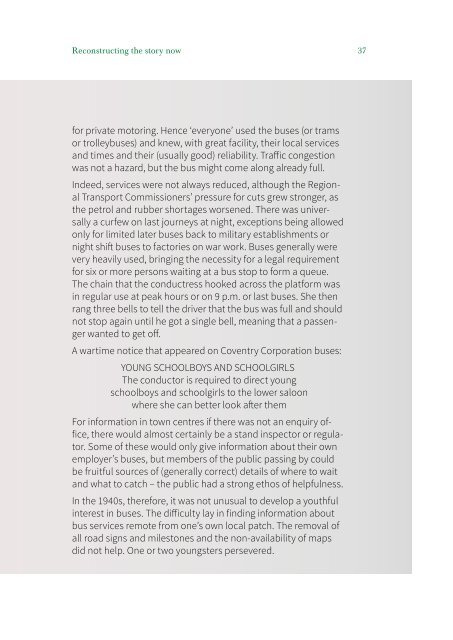Roger Atkinson - Blackout, Austerity and Pride
Blackout, Austerity and Pride – Life in the 1940s is a book written primarily from actual experience. It tells how an alert and intelligent boy, effectively orphaned at the age of 13, sets out to gain a foothold in life. Aided by some resourceful women, he unites a thirst for knowledge with a growing passion for places and buses and a strong sense of duty. http://www.memoir1940s.org.uk/
Blackout, Austerity and Pride – Life in the 1940s is a book written primarily from actual experience. It tells how an alert and intelligent boy, effectively orphaned at the age of 13, sets out to gain a foothold in life. Aided by some resourceful women, he unites a thirst for knowledge with a growing passion for places and buses and a strong sense of duty.
http://www.memoir1940s.org.uk/
Create successful ePaper yourself
Turn your PDF publications into a flip-book with our unique Google optimized e-Paper software.
Reconstructing the story now<br />
37<br />
for private motoring. Hence ‘everyone’ used the buses (or trams<br />
or trolleybuses) <strong>and</strong> knew, with great facility, their local services<br />
<strong>and</strong> times <strong>and</strong> their (usually good) reliability. Traffic congestion<br />
was not a hazard, but the bus might come along already full.<br />
Indeed, services were not always reduced, although the Regional<br />
Transport Commissioners’ pressure for cuts grew stronger, as<br />
the petrol <strong>and</strong> rubber shortages worsened. There was universally<br />
a curfew on last journeys at night, exceptions being allowed<br />
only for limited later buses back to military establishments or<br />
night shift buses to factories on war work. Buses generally were<br />
very heavily used, bringing the necessity for a legal requirement<br />
for six or more persons waiting at a bus stop to form a queue.<br />
The chain that the conductress hooked across the platform was<br />
in regular use at peak hours or on 9 p.m. or last buses. She then<br />
rang three bells to tell the driver that the bus was full <strong>and</strong> should<br />
not stop again until he got a single bell, meaning that a passenger<br />
wanted to get off.<br />
A wartime notice that appeared on Coventry Corporation buses:<br />
YOUNG SCHOOLBOYS AND SCHOOLGIRLS<br />
The conductor is required to direct young<br />
schoolboys <strong>and</strong> schoolgirls to the lower saloon<br />
where she can better look after them<br />
For information in town centres if there was not an enquiry office,<br />
there would almost certainly be a st<strong>and</strong> inspector or regulator.<br />
Some of these would only give information about their own<br />
employer’s buses, but members of the public passing by could<br />
be fruitful sources of (generally correct) details of where to wait<br />
<strong>and</strong> what to catch – the public had a strong ethos of helpfulness.<br />
In the 1940s, therefore, it was not unusual to develop a youthful<br />
interest in buses. The difficulty lay in finding information about<br />
bus services remote from one’s own local patch. The removal of<br />
all road signs <strong>and</strong> milestones <strong>and</strong> the non-availability of maps<br />
did not help. One or two youngsters persevered.


















